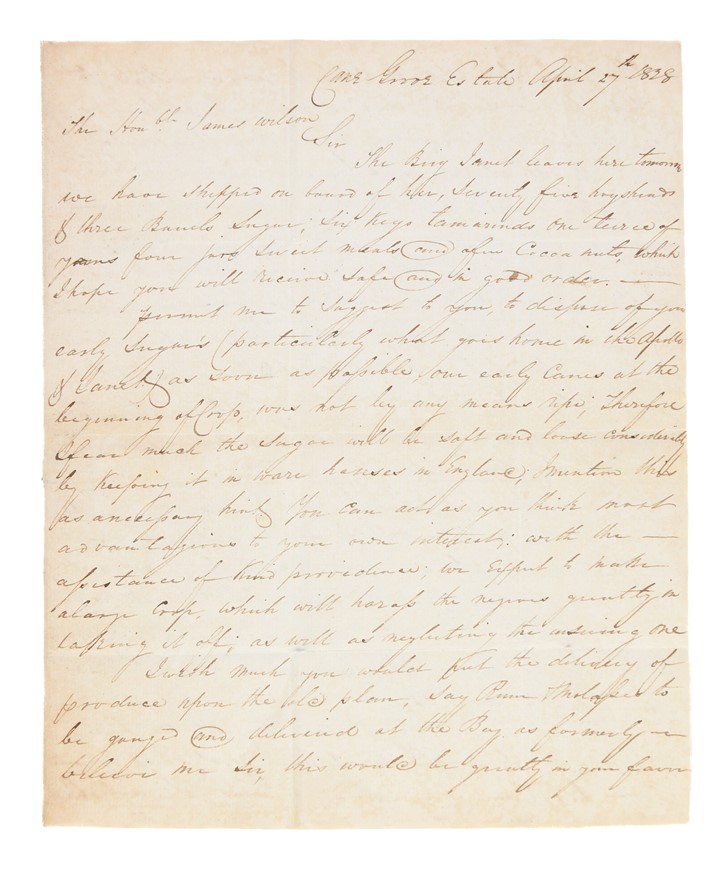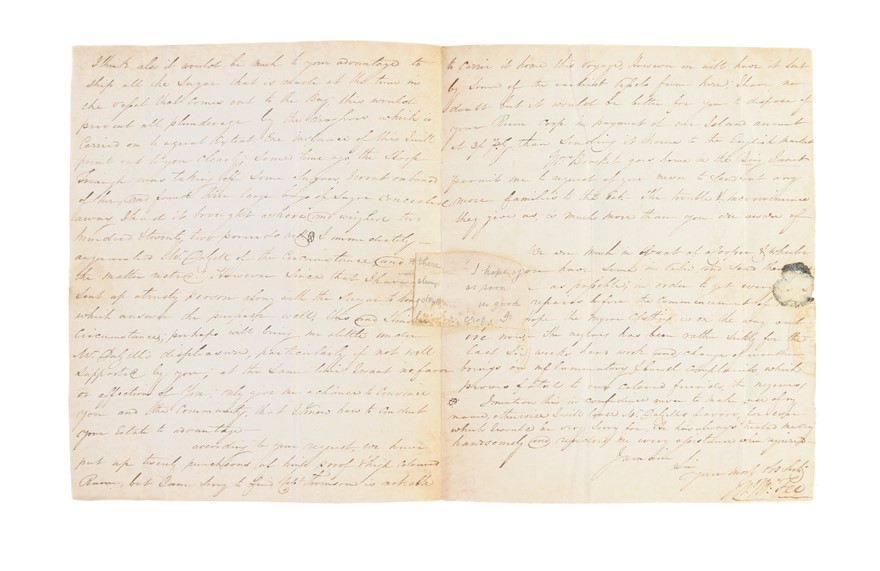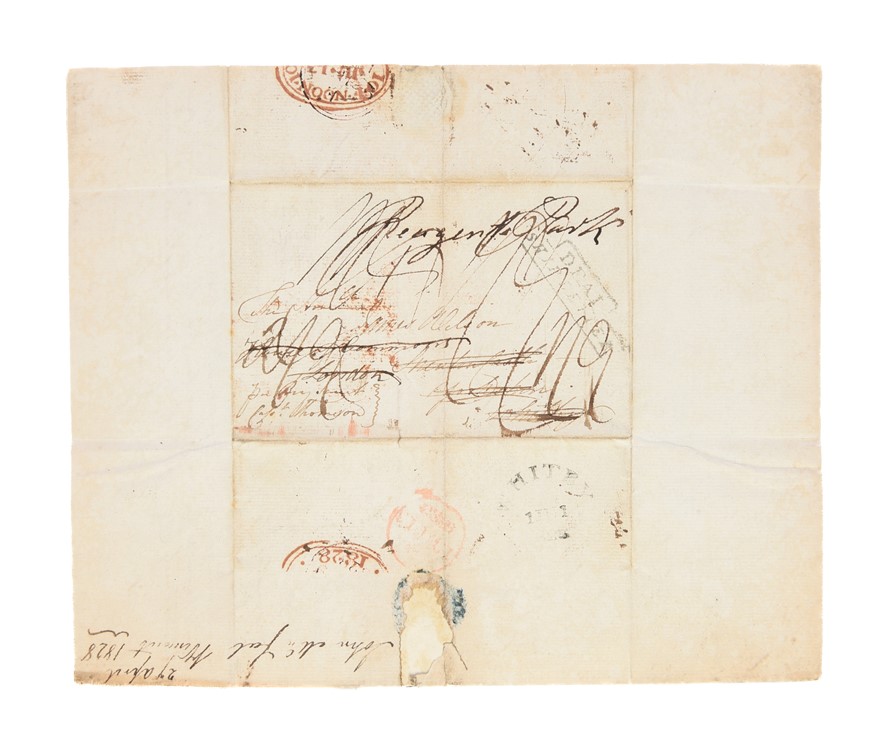ALS to Hon. James Wilson regarding his plantation Cane Grove on St Vincent.
McFEE John (1828.)
£950.00
DETAILS OF THE SUGAR HARVEST ON THE PLANTATION WHERE ASHTON WARNER WAS ENSLAVED
Autograph manuscript in ink, signed. Small 4to. A small repair from being poorly opened, about 10 words of text supplied over this repair in pencil facsimile. 4pp. St Vincent, 27 April,
An interesting letter from John McFee, manager of James Wilson's estate, Cane Grove, on St Vincent. The letter gives insight into some of the planter class's concerns in the West Indies in the early nineteenth century, five years before the Slavery Abolition Act of 1833. At this time, though the transatlantic slave trade had been outlawed, the plantations continued to operate using the forced labour of enslaved workers.
McFee begins by listing the goods sent back to England on the Brig Janet and encourages Wilson to consolidate his sugar shipments on the regular ship coming out to the bay. There were instances of "plunderage" on the local droghers (coasting vessels) and McFee outlines a recent instance when he discovered 220 pounds of Wilson's sugar concealed on the sloop Triangle and the subsequent measure of sending "a trustworthy person" to accompany the sugar.
The calculated deployment of the year's sugar crop is at the forefront if McFee's mind: "Permit me to suggest to you, to dispose of your early sugars (particularly what goes home in the Appolo & Janet) as soon as possible, our early canes at the beginning of the crop, was not by any means ripe. Therefore I fear much of the sugar will be soft and loose considerably by keeping it in warehouses in England; I mention this as a necessary hint. You can act as you think most advantageous your own interest; with the assistance of kind providence; we expect to make a large crop, which will harass the negroes greatly in taking it off; as well as neglecting the ensuing one." He goes on to inform him that they "have put up twenty puncheons of high proof rum & high coloured Rum" and suggests they use it to clear their island account instead of shipping it back to England.
Finally, there is mention of a woman, Mrs Becket, who is to be sent home with the Janet. On this topic McFee makes one additional plea: "permit me to request of you never to send out any more families to the Estate. The trouble & inconvenience is much more than you are aware of."
Unusually, there is an extant account of life on this plantation from the perspective of an enslaved worker with which to contextualise this letter. The 1831 publication Negro Slavery described by a Negro: Being the Narrative of Ashton Warner, a Native of St. Vincent was narrated by Warner to abolitionist Susanna Strickland. Warner contested the legality of his bondage on James Wilson's plantation, claiming that his freedom was purchased by a relative when in his infancy, from the estate of the Cane Grove's previous owner. According to Warner's account, Wilson captured him at ten years old and forced him to leave his family and return to the plantation. Strickland's introduction to his narrative suggests that his escape to England was in part to escalate his claim of lawful manumission in the British courts, however he died before having the opportunity to initiate proceedings, and indeed before the publication of this book. Warner's description of Wilson is far from favourable. He states that he was "considered one of the severest masters in the whole island" (Strickland, 26), and carried bitter resentment for the way in which Wilson cheated him of his freedom. Warner also describes the transition from Wilson's previous overseer to John McFee: "[a]nother manager came in his place, called Mr. John M'Fie, who was a very severe task-master, and worked the slaves much harder. Under him my condition became considerably worse. One day he sent and called me to his house, and said that, as there was not sufficient job-work for me about the homestall, I must take a hoe and join the field gang. If the sentence of death had been passed upon me, I could not have felt more stunned" (ibid, 32). Warner's account also includes a detailed description of the brutal work required to process the sugar harvest on Cane Grove - a chilling expansion on what McFee alludes to when he mentions in his letter that the "large crop ... will harass the negroes greatly".
James Wilson (1772-1830) served as MP for York from 1826 until his death. It is no great surprise that he opposed abolition bills in the House, advocating instead for property owners in the West Indies. He lived at Sneaton Castle in Whitby. In 1827 the Cane Grove estate, in the St. Andrew parish, had an enslaved population of 231. Following the 1833 Slavery Abolition Act, a claim for £5933 0s 5d was made on 26th Feb 1836 against the 206 enslaved persons lost by the Cane Grove estate through emancipation. The claim mentions that the register was completed by John McFee on behalf of his deceased employer in 1834.
Strickland, Susanna ed. Negro Slavery described by a Negro: Being the Narrative of Ashton Warner, a Native of St. Vincent. London, S. Maunder, 1831; Centre For the Study of the Legacies of British Slavery "St Vincent 568 (Cane Grove)" <https://www.ucl.ac.uk/lbs/claim/view/25762> (Accessed 5 March 2024); History of Parliament Online "WILSON, James (d.1830)" <https://www.historyofparliamentonline.org/volume/1820-1832/member/wilson-james-1830> (Accessed 5 March 2024).
Stock Code: 204125






